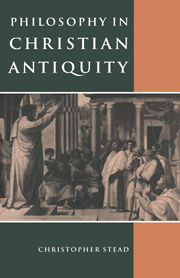Book contents
- Frontmatter
- Contents
- Preface
- List of abbreviations
- PART I THE PHILOSOPHICAL BACKGROUND
- PART II THE USE OF PHILOSOPHY IN CHRISTIAN THEOLOGY
- 8 The debate about Christian philosophy
- 9 Greek and Hebrew conceptions of God
- 10 Proofs of the existence of God
- 11 God as simple unchanging Being
- 12 How God is described
- 13 Logos and Spirit
- 14 Unity of substance
- 15 Substance and Persons
- 16 Christ as God and Man
- 17 Two natures united
- PART III AUGUSTINE
- Bibliography
- Index of Names
- Index of Subjects
14 - Unity of substance
Published online by Cambridge University Press: 29 September 2009
- Frontmatter
- Contents
- Preface
- List of abbreviations
- PART I THE PHILOSOPHICAL BACKGROUND
- PART II THE USE OF PHILOSOPHY IN CHRISTIAN THEOLOGY
- 8 The debate about Christian philosophy
- 9 Greek and Hebrew conceptions of God
- 10 Proofs of the existence of God
- 11 God as simple unchanging Being
- 12 How God is described
- 13 Logos and Spirit
- 14 Unity of substance
- 15 Substance and Persons
- 16 Christ as God and Man
- 17 Two natures united
- PART III AUGUSTINE
- Bibliography
- Index of Names
- Index of Subjects
Summary
We are accustomed to sum up the Christian doctrine of the Trinity in the Latin formula derived from Tertullian, three Persons in one substance. Greek theologians confess three hypostases but one ousia. The last two words, whatever their precise meaning, are clearly authorized by the Nicene Creed – both the original version of 325 and the customary version attributed to the Council of 381 – which states that the Son is homoousios with the Father; the word can be rendered in Latin form either as ‘consubstantial’ or as ‘coessential’. But problems arise from the fact that the Latin word essentia, which is the exact equivalent of ousia, fell out of use. Latin theologians therefore translated ousia by substantia which is etymologically equivalent to the Greek ‘hypostasis’. The Latins thus used substantia to express the divine unity; the Greeks used the corresponding word to confess three hypostases: Father, Son and Spirit. Consequently the Greeks were liable to suppose that the Latin una substantia (like ‘one hypostasis’) denies the Trinity. The Latins, conversely, could suspect the Greeks of preaching ‘three substances’, three distinct or different Godheads. Nor was this merely a difference of technical terms; both sides were to some extent influenced by their own terminology, so that at important moments the Latins were inclined to put their main emphasis on divine unity, the Greeks on a clearly articulated Trinity.
The word homoousios has been much discussed; but the traditional explanations are unreliable. We begin by considering its constituent parts. First, the prefix homo- suggests unity or togetherness; but its sense is not perfectly constant.
- Type
- Chapter
- Information
- Philosophy in Christian Antiquity , pp. 160 - 172Publisher: Cambridge University PressPrint publication year: 1994



